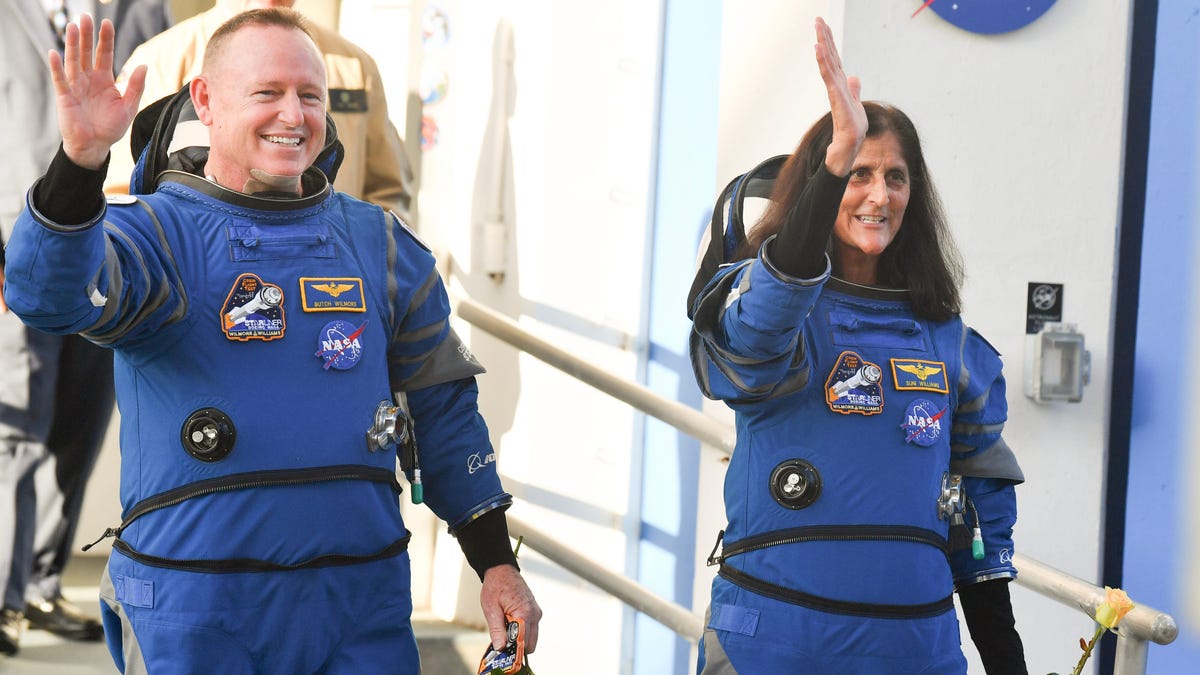Astronauts left behind by Starliner ready for press briefing from ISS: Overview of the space journey
NASA astronauts Butch Wilmore and Suni Williams will hold a press conference on the International Space Station this Friday afternoon, about a week after their original spacecraft, the Boeing Starliner, made its return to Earth without them.
The astronauts are expected to field questions from the media at 2:15 p.m. ET on Friday. They launched on June 5 aboard Boeing’s Starliner spacecraft, reaching the ISS on June 6. Initially, they thought they’d be back in time for the 4th of July, but now they won’t return to Earth until New Year’s.
Following a comprehensive evaluation of the Starliner after its landing on June 6, NASA officials determined that the spacecraft was not ready to safely transport Wilmore and Williams back home. The responsibility for bringing them back will now be handed over to Boeing’s competitor, SpaceX.
The uncrewed Starliner successfully returned to Earth earlier this month to make room for the postponed SpaceX Crew-9 mission, which is set to arrive at the ISS on September 24 for a six-month duration.
The Dragon spacecraft transporting Crew-9 will now also serve as Wilmore and Williams’s ride home. Consequently, Crew-9 will carry only two astronauts instead of four, according to NASA. The duo is expected to return on February 25, 2025, alongside Crew-9 on the Dragon after the SpaceX team concludes their six-month mission at the station.
Let’s recap the significant events of the Boeing Starliner’s first crewed mission, featuring delays in scrubbing, launching, and returning.
May 6: Starliner launch canceled hours before liftoff
After years of development, the third orbital flight test for Starliner was set for launch when engineers discovered an issue with the pressure regulation valve in the rocket’s upper stage liquid oxygen tank, prompting a last-minute cancelation for safety reasons, as stated by NASA. The United Launch Alliance emphasized this decision was made to prioritize the safety of all involved personnel.
June 1: Another launch attempt scrubbed
On June 1, the Starliner seemed ready for launch, and NASA decided to proceed without fixing a helium leak since the chemical is neither flammable nor toxic. However, just minutes before the launch, a computer malfunction prompted another cancellation, according to NASA’s update on X, formerly known as Twitter.
June 5: Starliner finally launches
Finally, on June 5, the Starliner took off successfully. Boeing Space confirmed via X at 11:44 a.m. that Starliner had achieved a stable orbit and detached from the Atlas V rocket. The spacecraft then proceeded to activate its engines to travel to the ISS, NASA noted.
June 6: Starliner docks at ISS
The next day, the Starliner docked at 1:34 p.m. EDT at the forward port of the ISS’s Harmony module. However, NASA announced that two additional helium leaks were found on the spacecraft after it reached orbit.
June 9: NASA updates the return schedule
Although Wilmore and Williams were expected to stay at the ISS for only a week, NASA updated via X that their landing back in the New Mexico desert would likely not occur before June 18. The agency mentioned that the extended stay would allow the astronauts to support a spacewalk and give engineers additional time for system checks on the Starliner.
June 14: Another return delay
The return was postponed again, with the astronauts now scheduled to undock from the ISS no earlier than June 25, landing on June 26 at White Sands Space Harbor in New Mexico, per a Boeing statement.
June 21: Delays continue
Boeing and NASA once again postponed the astronauts’ return, now estimating July at the earliest. The agencies cited “ongoing planned spacewalks” and the need for mission teams to analyze propulsion system data as the reasons for further delays.
July 10: Astronauts remain positive
Wilmore and Williams appeared in a NASA broadcast from the ISS, where Williams remarked that they had no complaints about their extended stay. Meanwhile, teams of scientists and engineers continued to analyze and address issues encountered during the Starliner’s flight, including thruster anomalies and helium leaks.
July 25: No official return date yet
During a press conference, NASA and Boeing reported that an official return date for the Starliner was still undetermined. However, NASA’s Commercial Crew Program Manager, Steve Stich, expressed confidence that they were “making great progress.”
August: Astronauts assist at ISS while awaiting return
Both Wilmore and Williams, who were Navy test pilots before joining NASA, had been scheduled for limited time at the ISS to test the Starliner and its systems. With their stay now extended indefinitely, they supported ISS crew operations as their wait continued.
August 24: Return deferred to February 2025
NASA officials announced on August 24 that Wilmore and Williams would remain at the ISS until February 2025 after concluding that it was too dangerous to return them to Earth on the Boeing spacecraft at this time.
The spacecraft is scheduled to return on a SpaceX rocket that is expected to dock at the ISS in September.
September 6-7: Starliner Departs ISS, Heads Back to Earth
The unfortunate Starliner spacecraft undocked from the ISS without astronauts Wilmore and Williams on board and began its journey back to Earth shortly after midnight on September 7. It successfully landed in the New Mexico desert, utilizing parachutes and an airbag at NASA’s White Sands Space Harbor site. Boeing teams have commenced recovery operations for the spacecraft, which will be transported back to Kennedy Space Center for assessment.
Eric Lagatta reports on breaking and trending news for YSL News.
Gabe Hauari is a national trending news reporter at YSL News. You can follow him on X @GabeHauari

